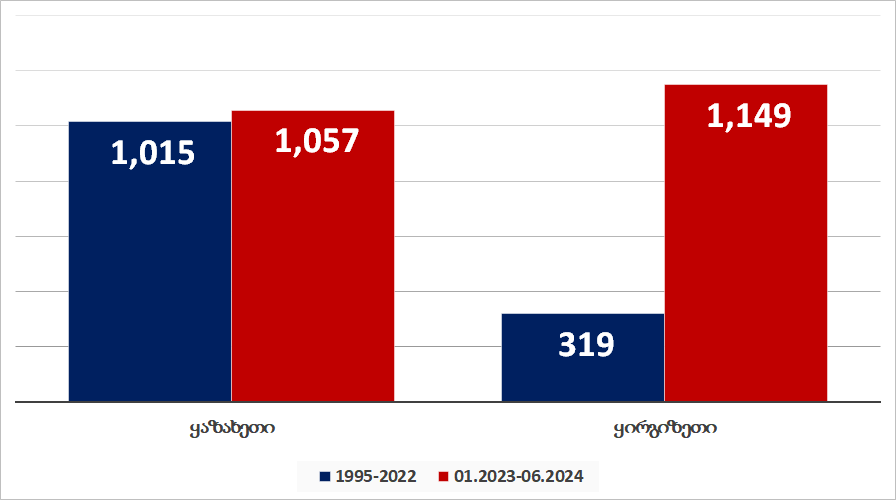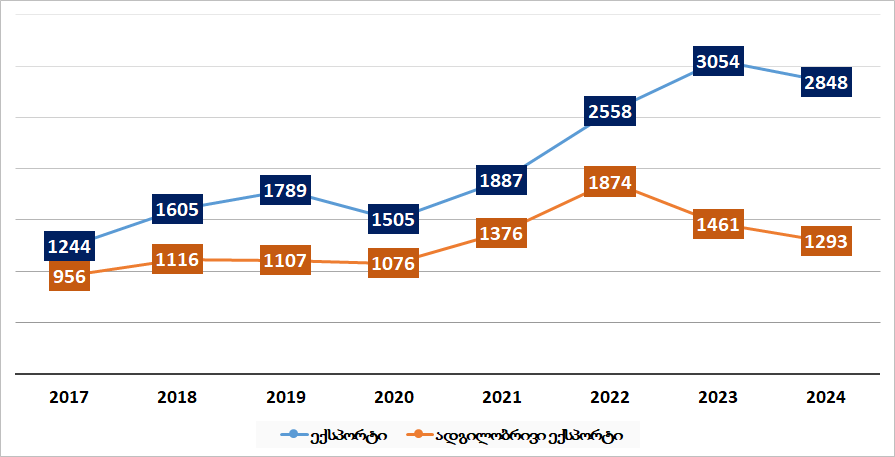Vakhtang Tsintsadze: “Exports reached a historical maximum in June with local export also experiencing an increase.”
Verdict: FactCheck concludes that Vakhtang Tsintsadze’s statement is HALF TRUE.
Exports of goods reached a monthly peak of USD 582 million in June 2024. Furthermore, local exports, representing exports excluding re-exports, increased by 11% as compared to the same period last year, reaching USD 270 million.
Despite the growth in June, the total exports over the past six months decreased by 6.7% as compared to the same period of the previous year. The decline exhibited by local export trends is even more pronounced as this metric falls 11.5% and 31% behind the data of the same periods in 2023 and 2024, respectively. The local export figures of the six-month period did not surpass those from the first half of 2021.
Record export figures were largely influenced by re-exports in both the previous year and June of the current year. Whilst re-exports contribute to the economy, local exports have a greater impact in terms of employment and tax revenue.
Whilst the data is accurate, Mr Tsintsadze only referred to a specific one-month period which may potentially lead to misinterpretation of the information. Thus, FactCheck concludes that Vakhtang Tsintsadze’s statement is HALF TRUE.
Analysis
Whilst commenting on exports, the Deputy Minister of Economy and Sustainable Development, Vakhtang Tsintsadze, stated: “Exports increased by approximately 6% in June 2024, representing a historical maximum of USD 582.1 million. Local exports experienced a 11.3% increase as compared to the same period the previous year, amounting to USD 270.2 million.”
Exports of goods reached USD 582 million in June 2024, representing a monthly peak since 1995.
Despite the peak levels recorded in June, there has been a 6.7% decline in terms of the aggregate data for the first six months of the year. Total exports in the period from January to June in 2024 decreased by USD 206 million as compared to the same period last year. Notably, exports declined both in the first and the second quarters. Whilst there was a slight increase in February and June, January, March, April and May were characterised by a downward trend.
Kyrgyzstan ranks first in exports with a total of USD 453 million where 91%, or USD 415 million, is accounted for by light vehicles and 5%, or USD 24 million, by tobacco products, both of which are re-exports. Notably, 98.5% of the products exported to Kyrgyzstan were re-exports with only 1.2% being local exports over the initial six months of the current year.
Kazakhstan follows Kyrgyzstan with re-exports of light vehicles accounting for 86% or USD 304 million for the total exports. Russia ranks third with total exports reaching USD 340 million. The next places in the ranking are held by Azerbaijan, Armenia, Turkey, China, Ukraine, Switzerland and Uzbekistan.
The traditional markets for exports have been neighbouring countries for nearly three decades (excluding Russia from 2006 to 2012 due to the embargo). Notably, China has been added to the aforementioned list of key markets, particularly towards the end of the 2010s.
A substantial increase in exports to Central Asia, particularly to Kyrgyzstan, began in 2023. Georgia has exported more products to Kazakhstan in the past 1.5 years than it did from 1995 to 2022 combined. Furthermore, it has exported more to Kyrgyzstan in the last six months than in the aggregate period from 1995 to 2022.
Graph 1: Exports (USD Million)

Source: National Statistics Office of Georgia
Exports to Turkey increased by 16% whilst exports to Russia experienced a marginal decline of 1% amongst the neighbouring economies. Additionally, a significant 23% drop was recorded in exports to Azerbaijan and exports to Armenia declined by an even larger 37%. Although China was in the top position as the leading export partner for Georgia from 2020 to 2022, it fell to the seventh place as exports to China dropped by 34%.
Light vehicles represent the primary export products with a 32.8% share. Wine ranks second with exports amounting to USD 157 followed by ferroalloys at USD 143 million. Other products in the list of top ten include spirituous beverages, precious metals, mineral waters, nitrogen fertilisers, carbonated waters, medical products and gold.
Whilst local exports experienced a 11% increase from USD 242 million to USD 270 million in June, this rise appears to be an isolated event. Local exports have exhibited a downward trend for the previous five months during the current year. Local exports decreased by 11.5% to USD 1.3 billion from January to June as compared to the same period the previous year. This figure is not only lower than the 2023 figure but also falls behind the 2021 levels.
Graph 2: Exports from January to June (USD Million)

Source: National Statistics Office of Georgia
Local exports are far from record highs unlike total exports. Local exports constituted USD 282 million in June 2022 and USD 389 million in May 2022.
The decline in total exports, coupled with a rise in re-exports, has substantially reduced the share of local exports. This metric averaged 71% of total exports from 2017 to 2022 (from January to June), dropping to 48% in 2023 and even further to 45% in 2024.
Whilst the Deputy Minister of Economy and Sustainable Development emphasised the data of June for total and local exports, the six-month period shows a decrease in both metrics. Whilst the data is accurate, Mr Tsintsadze only referred to a specific one-month period which may potentially lead to a misinterpretation of the information. Thus, FactCheck concludes that Vakhtang Tsintsadze’s statement is HALF TRUE.







